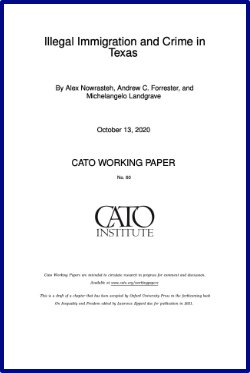By Alex Nowrasteh
Crime committed by illegal immigrants is an important public policy issue that should affect the allocation of federal immigration enforcement resources, state and local law enforcement resources, and policies toward arresting, detaining, and removing illegal immigrants.1 This brief uses Texas Department of Public Safety data to measure the rate at which individuals were convicted and arrested by crime and immigration status in Texas in 2019. This brief is an update, expansion, and improvement of earlier publications that measured criminal conviction and arrest rates by immigration status in Texas in 2015, 2017, and 2018 using the same data source. The results in this updated brief show that in Texas in 2019, illegal immigrants were 37.1 percent less likely to be convicted of a crime than native-born Americans and legal immigrants were about 57.2 percent less likely to be convicted of a crime than native-born Americans. The conviction and arrest rates for illegal immigrants were lower than those for native-born Americans but higher than those for legal immigrants. This result holds for just about every type of crime, including homicide, sex crimes, larceny, and most other crimes.
Washington, DC: Cato Institute, 2021. 7p.





















